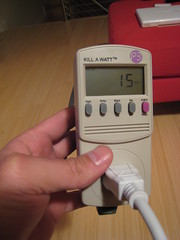I just unplugged the microwave, our coffee pot, a battery recharger for our Dewalt power tool kit and turned off the old timey record turntable/radio/tape player that was on “standby”. I just saved enough power in one day to power a hut in Africa or a Southern Asia for a month! Americans don’t get the fact that they waste, waste, waste. Worse then that we are role models for the world. The big 5 of the future – Brazil, South Africa, India, China and Australia all want to be like us. If they succeed humanity could cease to exist.
http://green.yahoo.com/blog/the_conscious_consumer/4/what-s-wasting-energy-in-your-home-right-now.html
What’s wasting energy in your home right now?
By Lori Bongiorno Posted Thu Oct 9, 2008 9:34am PDT

Virtually all of your electronics are sucking up energy even if they’re turned off or not being used. Some of the biggest culprits include your TV, computer, and printer. Even your electric toothbrush is drawing energy when it’s plugged in and sitting idle.
On its own, the “vampire power” used by one device might seem miniscule, but collectively it amounts to more than $4 billion a year of wasted energy here in the United States. What’s more, the Department of Energy says that about 75 percent of the electricity used to power home electronics is consumed while the products are turned off.
The easiest (and most obvious) thing you can do is get up right now and unplug whatever you’re not using. Candidates include:
- Your hand-held vacuum in its charging station
- Power drills
- Automatic coffee makers
- The VCR you haven’t used in nearly a decade
- The TV that’s collecting dust in the guest room
- The empty refrigerator in the garage
For the slightly more ambitious, buy a power strip at your local hardware store. Yes, it takes a little time up-front to plug everything into it, but you’ll more than make up the time when you can cut all power with just the flip of a switch.
Clamping down on vampire power is one of the easiest ways to save money on your electric bill (about 5 percent a month) and pump less carbon dioxide into the atmosphere. It may not seem like much, but it all adds up!
Environmental journalist Lori Bongiorno shares green-living tips and product reviews with Yahoo! Green’s users. Send Lori a question or suggestion for potential use in a future column. Her book, Green Greener Greenest: A Practical Guide to Making Eco-smart Choices a Part of Your Life, is available on Yahoo! Shopping.
:}
http://en.wikipedia.org/wiki/Standby_power
For systems that provide auxiliary power, see Emergency power system.
“Phantom load” redirects here. For microphone powering technique, see Phantom power.
Standby power, also called vampire power, phantom load, or leaking electricity, refers to the electric power consumed by electronic appliances while they are switched off or in a standby mode. A very common “electricity vampire” is a power adapter which has no power-off switch. Some such devices offer remote controls and digital clock features to the user, while other devices, such as power adapters for laptop computers and other electronic devices, consume power without offering any features.
:}
I love the leaking electricity phrase – what it falls on the ground and makes a puddle?
:}
The British Government’s 2006 Energy Review found that standby modes on electronic devices account for 8% of all British domestic power consumption. A similar study in France in 2000 found that standby power accounted for 7% of total residential consumption. Further studies have since come to similar conclusions in other developed countries, including the Netherlands, Australia and Japan. Some estimates put the proportion of consumption due to standby power as high as 13%.
:]
To counter that is this little fellow. Unfortunately he doesn’t test anything with a CLOCK or LIGHT Display which do use power when turned off. Just think about the juice we use on clocks alone! Every house hold in America no matter how poor has an alarm clock that uses electricity. Is this necessary?
:]
http://theonda.org/articles/2008/03/09/mythbusting-vampire-power-suckers
Fast on the heels of my energy-on-the-brain week in San Diego, I decided to run some experiments with my recently acquired Kill-a-Watt to debunk some myths about consumer electronics and power consumption. What follows is by no means exhaustive, but I figured I would write it up as it has frequently been the topic of lunchtime conversation at the office— with people arguing both sides of each argument as though it were politics and not simply electricity 101.
The basic statement that I was trying to confirm or disprove was that your computer/cellphone/ipod/etc. charger sucks electricity even when it is not connected to a device. Savvy environmental marketers have called this the “vampire effect” or the problem of “phantom power,” and truth be told, after I first heard the term, I could never look at one of those cuddly black bricks the same.
 So I went around the house looking for as many bricks as possible, putting my Kill-a-Watt between them and the wall source of power and then connecting and disconnecting their associated devices. An aside: For those that don’t know what a Kill-a-Watt is (pictured here), it’s one of several cheap gizmos you can buy to plug between a given appliance and the wall to measure how much power is being consumed. I’m not quite sure how it works, but quickly testing it on both 60 and 100 Watt lightbulbs convinced me that it worked as billed.
So I went around the house looking for as many bricks as possible, putting my Kill-a-Watt between them and the wall source of power and then connecting and disconnecting their associated devices. An aside: For those that don’t know what a Kill-a-Watt is (pictured here), it’s one of several cheap gizmos you can buy to plug between a given appliance and the wall to measure how much power is being consumed. I’m not quite sure how it works, but quickly testing it on both 60 and 100 Watt lightbulbs convinced me that it worked as billed.
The result: for each of the 13 bricks that I tried, ranging from a wireless phone charger to a MacBook Pro power adapter, the vampire/phantom thing is complete BS. The moment you disconnect the associated device the Watts measured on the Kill-a-Watt go right down to zero. Interestingly enough, this is equally true for low wattage chargers like the iPhone one (~1-2W while charging). It makes sense— after all I’m fairly certain that a fairly cheap circuit on the power adapter can get a good sense of load and just cut the whole power supply off if nothing is connected. As a funny aside, it seems that there is a whole category of “smart powerstrips” that are sold to protect the user against this bunk phantom power thing.
:}
:}





